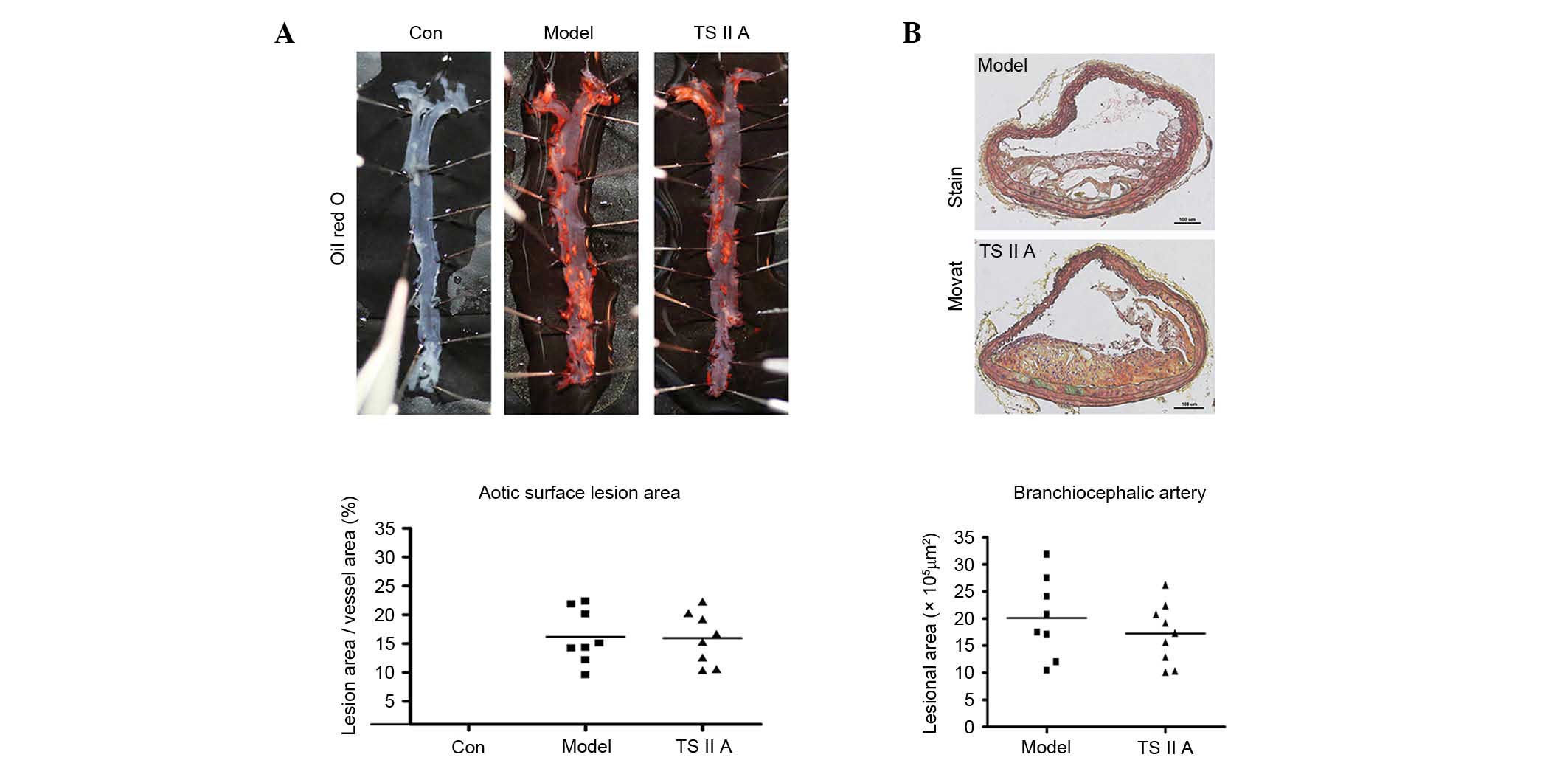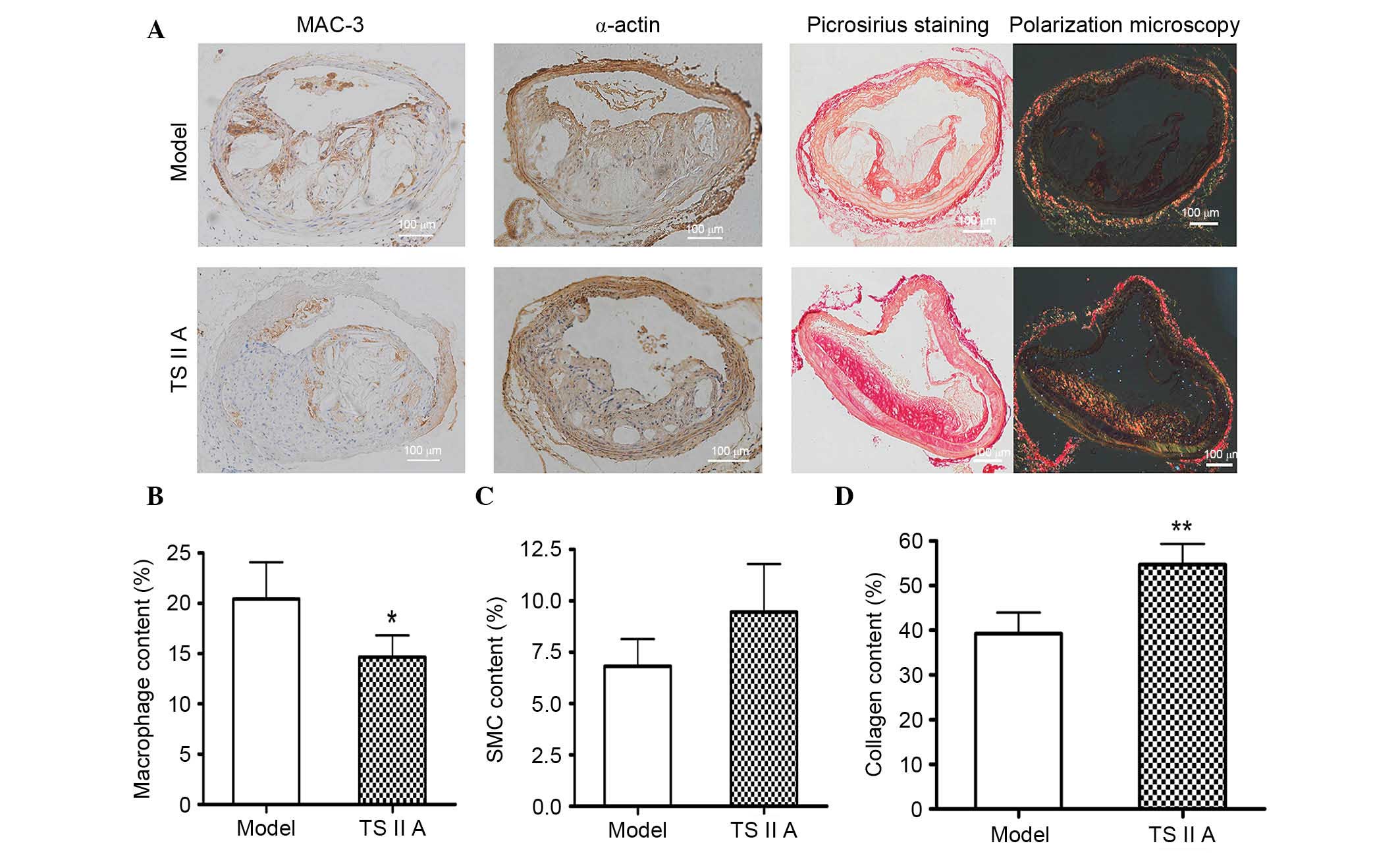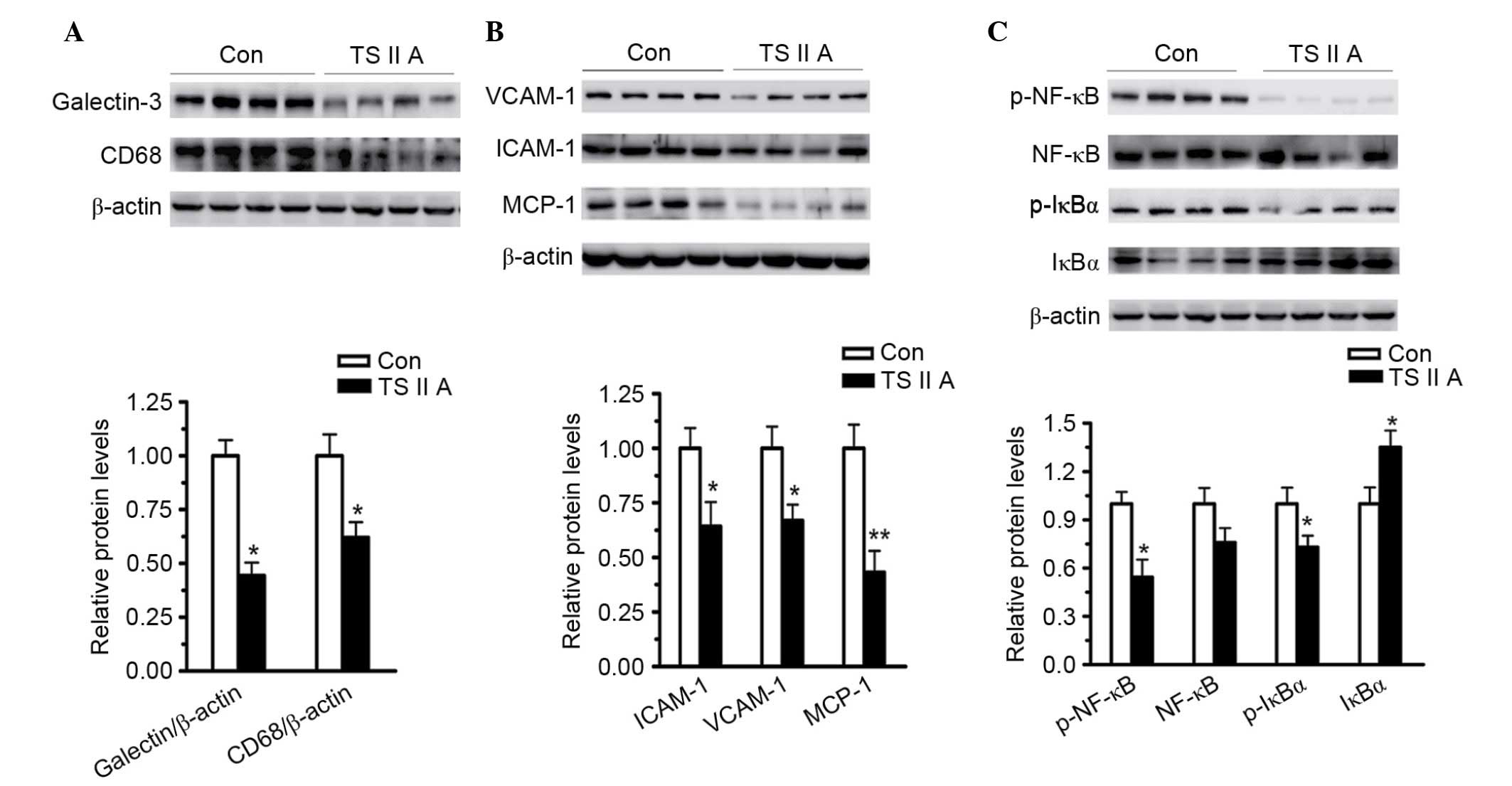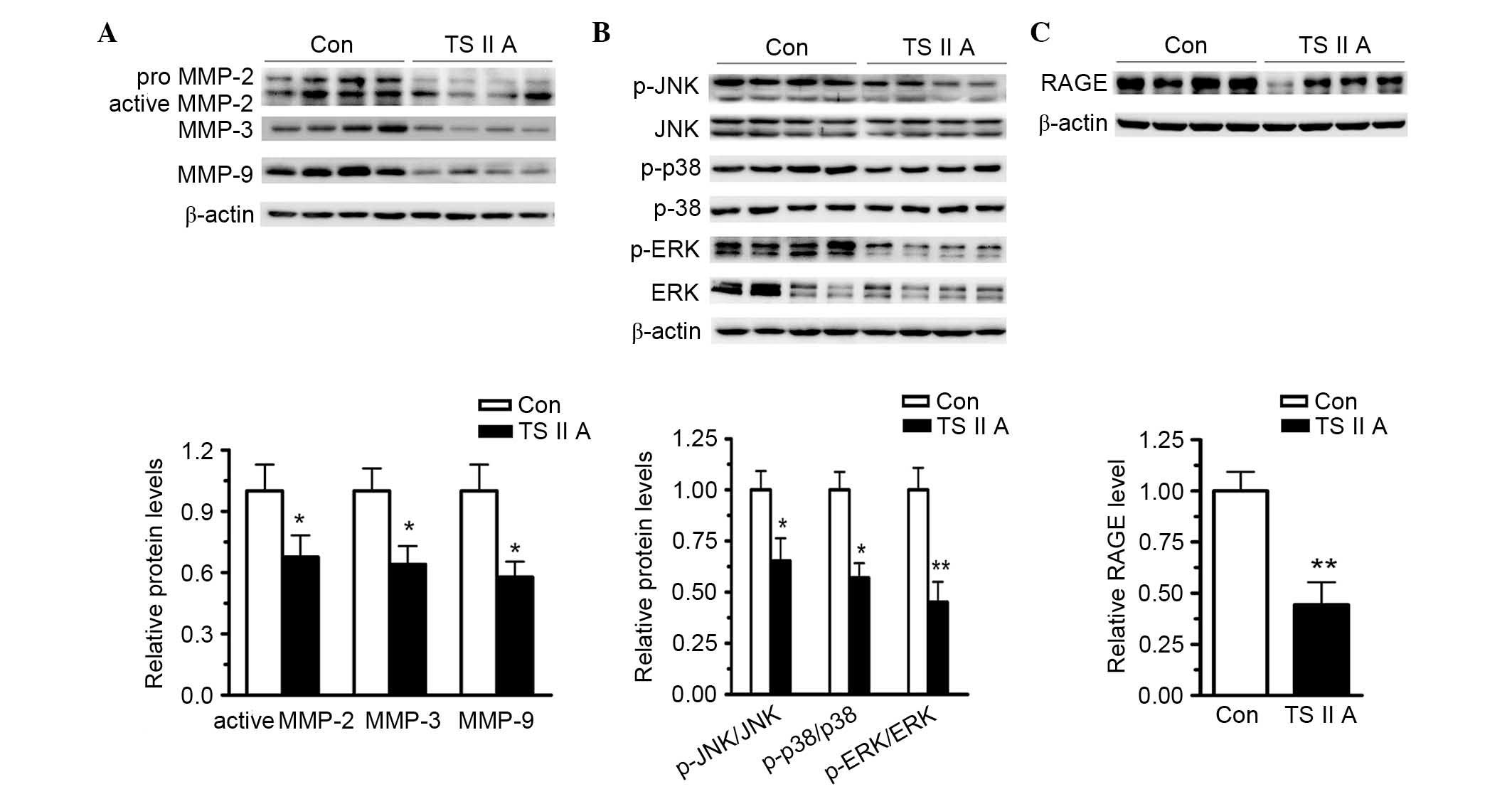|
1
|
Burke AP, Kolodgie FD, Farb A, Weber D and
Virmani R: Morphological predictors of arterial remodeling in
coronary atherosclerosis. Circulation. 105:297–303. 2002.
View Article : Google Scholar : PubMed/NCBI
|
|
2
|
Stoll G and Bendszus M: Inflammation and
atherosclerosis: Novel insights into plaque formation and
destabilization. Stroke. 37:1923–1932. 2006. View Article : Google Scholar : PubMed/NCBI
|
|
3
|
Newby AC, George SJ, Ismail Y, Johnson JL,
Sala-Newby GB and Thomas AC: Vulnerable atherosclerotic plaque
metalloproteinases and foam cell phenotypes. Thromb Haemost.
101:1006–1011. 2009.PubMed/NCBI
|
|
4
|
Gough PJ, Gomez IG, Wille PT and Raines
EW: Macrophage expression of active MMP-9 induces acute plaque
disruption in apoE-deficient mice. J Clin Invest. 116:59–69. 2006.
View Article : Google Scholar : PubMed/NCBI
|
|
5
|
Silence J, Lupu F, Collen D and Lijnen HR:
Persistence of atherosclerotic plaque but reduced aneurysm
formation in mice with stromelysin-1 (MMP-3) gene inactivation.
Arterioscler Thromb Vasc Biol. 21:1440–1445. 2001. View Article : Google Scholar : PubMed/NCBI
|
|
6
|
Bäck M, Ketelhuth DF and Agewall S: Matrix
metalloproteinases in atherothrombosis. Prog Cardiovasc Dis.
52:410–428. 2010. View Article : Google Scholar : PubMed/NCBI
|
|
7
|
Toutouzas K, Synetos A, Nikolaou C,
Tsiamis E, Tousoulis D and Stefanadis C: Matrix metalloproteinases
and vulnerable atheromatous plaque. Curr Top Med Chem.
12:1166–1180. 2012. View Article : Google Scholar : PubMed/NCBI
|
|
8
|
Berg G, Miksztowicz V and Schreier L:
Metalloproteinases in metabolic syndrome. Clin Chim Acta.
412:1731–1739. 2011. View Article : Google Scholar : PubMed/NCBI
|
|
9
|
Sun L, Ishida T, Yasuda T, Kojima Y, Honjo
T, Yamamoto Y, Yamamoto H, Ishibashi S, Hirata K and Hayashi Y:
RAGE mediates oxidized LDL-induced pro-inflammatory effects and
atherosclerosis in non-diabetic LDL receptor-deficient mice.
Cardiovasc Res. 82:371–381. 2009. View Article : Google Scholar : PubMed/NCBI
|
|
10
|
Harja E, Bu DX, Hudson BI, Chang JS, Shen
X, Hallam K, Kalea AZ, Lu Y, Rosario RH, Oruganti S, et al:
Vascular and inflammatory stresses mediate atherosclerosis via RAGE
and its ligands in apoE−/− mice. J Clin Invest.
118:183–194. 2008. View
Article : Google Scholar : PubMed/NCBI
|
|
11
|
Zhang F, Banker G, Liu X, Suwanabol PA,
Lengfeld J, Yamanouchi D, Kent KC and Liu B: The novel function of
advanced glycation end products in regulation of MMP-9 production.
J Surg Res. 171:871–876. 2011. View Article : Google Scholar : PubMed/NCBI
|
|
12
|
Goldin A, Beckman JA, Schmidt AM and
Creager MA: Advanced glycation end products: Sparking the
development of diabetic vascular injury. Circulation. 114:597–605.
2006. View Article : Google Scholar : PubMed/NCBI
|
|
13
|
Hoefen RJ and Berk BC: The role of MAP
kinases in endothelial activation. Vascul Pharmacol. 38:271–273.
2002. View Article : Google Scholar : PubMed/NCBI
|
|
14
|
Bierhaus A, Schiekofer S, Schwaninger M,
Andrassy M, Humpert PM, Chen J, Hong M, Luther T, Henle T, Klöting
I, et al: Diabetes-associated sustained activation of the
transcription factor nuclear factor-kappaB. Diabetes. 50:2792–2808.
2001. View Article : Google Scholar : PubMed/NCBI
|
|
15
|
Kutuk O and Basaga H: Inflammation meets
oxidation: NF-kappaB as a mediator of initial lesion development in
atherosclerosis. Trends Mol Med. 9:549–557. 2003. View Article : Google Scholar : PubMed/NCBI
|
|
16
|
Tang FT, Cao Y, Wang TQ, Wang LJ, Guo J,
Zhou XS, Xu SW, Liu WH, Liu PQ and Huang HQ: Tanshinone IIA
attenuates atherosclerosis in ApoE (−/−) mice through
down-regulation of scavenger receptor expression. Eur J Pharmacol.
650:275–284. 2011. View Article : Google Scholar : PubMed/NCBI
|
|
17
|
Xu S, Little PJ, Lan T, Huang Y, Le K, Wu
X, Shen X, Huang H, Cai Y, Tang F, et al: Tanshinone II-A
attenuates and stabilizes atherosclerotic plaques in
apolipoprotein-E knockout mice fed a high cholesterol diet. Arch
Biochem Biophys. 515:72–79. 2011. View Article : Google Scholar : PubMed/NCBI
|
|
18
|
Smith JD and Breslow JL: The emergence of
mouse models of atherosclerosis and their relevance to clinical
research. J Intern Med. 242:99–109. 1997. View Article : Google Scholar : PubMed/NCBI
|
|
19
|
O'Neill TP: Apolipoprotein E-deficient
mouse model of human atherosclerosis. Toxicol Pathol. 25:20–1.
1997. View Article : Google Scholar : PubMed/NCBI
|
|
20
|
Basta G, Schmidt AM and De Caterina R:
Advanced glycation end products and vascular inflammation:
Implications for accelerated atherosclerosis in diabetes.
Cardiovasc Res. 63:582–592. 2004. View Article : Google Scholar : PubMed/NCBI
|
|
21
|
Garvey W, Fathi A, Bigelow F, Carpenter B
and Jimenez C: Improved Movat pentachrome stain. Stain Technol.
61:60–62. 1986. View Article : Google Scholar : PubMed/NCBI
|
|
22
|
Llewellyn BD: An improved Sirius red
method for amyloid. J Med Lab Technol. 27:308–309. 1970.PubMed/NCBI
|
|
23
|
Jan NJ, Grimm JL, Tran H, Lathrop KL,
Wollstein G, Bilonick RA, Ishikawa H, Kagemann L, Schuman JS and
Sigal IA: Polarization microscopy for characterizing fiber
orientation of ocular tissues. Biomed Opt Express. 6:4705–4718.
2015. View Article : Google Scholar : PubMed/NCBI
|
|
24
|
Hong X, Meng Y and Kalkanis SN: Serum
proteins are extracted along with monolayer cells in plasticware
and interfere with protein analysis. J Biol Methods. 3:e512016.
View Article : Google Scholar : PubMed/NCBI
|
|
25
|
Ahn KS and Aggarwal BB: Transcription
factor NF-kappaB: A sensor for smoke and stress signals. Ann N Y
Acad Sci. 1056:218–233. 2005. View Article : Google Scholar : PubMed/NCBI
|
|
26
|
Yamamoto Y and Gaynor RB: IkappaB kinases:
Key regulators of the NF-kappaB pathway. Trends Biochem Sci.
29:72–79. 2004. View Article : Google Scholar : PubMed/NCBI
|
|
27
|
Chistiakov DA, Sobenin IA and Orekhov AN:
Vascular extracellular matrix in atherosclerosis. Cardiol Rev.
21:270–288. 2013. View Article : Google Scholar : PubMed/NCBI
|
|
28
|
Chen Q, Jin M, Yang F, Zhu J, Xiao Q and
Zhang L: Matrix metalloproteinases: Inflammatory regulators of cell
behaviors in vascular formation and remodeling. Mediators Inflamm.
2013:9283152013. View Article : Google Scholar : PubMed/NCBI
|
|
29
|
Berg G, Miksztowicz V and Schreier L:
Metalloproteinases in metabolic syndrome. Clin Chim Acta.
412:1731–1739. 2011. View Article : Google Scholar : PubMed/NCBI
|
|
30
|
De Nooijer R, Verkleij CJ, von der Thüsen
JH, Jukema JW, van der Wall EE, van Berkel TJ, Baker AH and Biessen
EA: Lesional overexpression of matrix metalloproteinase-9 promotes
intraplaque hemorrhage in advanced lesionsbut not at earlier stages
of atherogenesis. Arterioscler Thromb Vasc Biol. 26:340–346. 2006.
View Article : Google Scholar : PubMed/NCBI
|
|
31
|
Razansky D, Harlaar NJ, Hillebrands JL,
Taruttis A, Herzog E, Zeebregts CJ, van Dam GM and Ntziachristos V:
Multispectral optoacoustic tomography of matrix metalloproteinase
activity in vulnerable human carotid plaques. Mol Imaging Biol.
14:277–285. 2012. View Article : Google Scholar : PubMed/NCBI
|
|
32
|
Murillo CA, Woodside KJ, Guo Q, Zhang S,
O'Connor KL and Hunter GC: Integrin and matrix metalloproteinase
expression in human carotid plaque. J Surg Res. 155:157–164. 2009.
View Article : Google Scholar : PubMed/NCBI
|
|
33
|
Wang F, Jin XP, Zhu M, Lin XF, Hu XF, Wang
WF, Han Z and Huang LZ: Genotype association of C(−735)T
Polymorphism of the MMP-2 gene with the risk of carotid
atherosclerosis-vulnerable plaque in the Han Chinese population.
Vasc Med. 16:13–18. 2011. View Article : Google Scholar : PubMed/NCBI
|
|
34
|
Reiner Z and Tedeschi-Reiner E: New
information on the pathophysiology of atherosclerosis. Lijec Vjesn.
123:26–31, (In Croatian). PubMed/NCBI
|
|
35
|
Boyle JJ: Macrophage activation in
atherosclerosis: Pathogenesis and pharmacology of plaque rupture.
Curr Vasc Pharmacol. 3:63–68. 2005. View Article : Google Scholar : PubMed/NCBI
|
|
36
|
Chen W, Tang F, Xie B, Chen S, Huang H and
Liu P: Amelioration of atherosclerosis by tanshinone IIA in
hyperlipidemic rabbits through attenuation of oxidative stress. Eur
J Pharmacol. 674:359–364. 2012. View Article : Google Scholar : PubMed/NCBI
|
|
37
|
Wei B, You MG, Ling JJ, Wei LL, Wang K, Li
WW, Chen T, Du QM and Ji H: Regulation of antioxidant system,
lipids and fatty acid β-oxidation contributes to the
cardioprotective effect of sodium tanshinone IIA sulphonate in
isoproterenol-induced myocardial infarction in rats.
Atherosclerosis. 230:148–156. 2013. View Article : Google Scholar : PubMed/NCBI
|
|
38
|
Fukami K, Yamagishi S and Okuda S: Role of
AGEs-RAGE system in cardiovascular disease. Curr Pharm Des.
20:2395–2402. 2014. View Article : Google Scholar : PubMed/NCBI
|
|
39
|
Cipollone F, Iezzi A, Fazia M, Zucchelli
M, Pini B, Cuccurullo C, De Cesare D, De Blasis G, Muraro R, Bei R,
et al: The receptor RAGE as a progression factor amplifying
arachidonate-dependent inflammatory and proteolytic response in
human atherosclerotic plaques: Role of glycemic control.
Circulation. 108:1070–1077. 2003. View Article : Google Scholar : PubMed/NCBI
|
|
40
|
Zhang F, Banker G, Liu X, Suwanabol PA,
Lengfeld J, Yamanouchi D, Kent KC and Liu B: The novel function of
advanced glycation end products in regulation of MMP-9 production.
J Surg Res. 171:871–876. 2011. View Article : Google Scholar : PubMed/NCBI
|
|
41
|
Cipollone F, Iezzi A, Fazia M, Zucchelli
M, Pini B, Cuccurullo C, De Cesare D, De Blasis G, Muraro R, Bei R,
et al: The receptor RAGE as a progression factor amplifying
arachidonate-dependent inflammatory and proteolytic response in
human atherosclerotic plaques: Role of glycemic control.
Circulation. 108:1070–1077. 2003. View Article : Google Scholar : PubMed/NCBI
|
|
42
|
Bucciarelli LG, Wendt T, Qu W, Lu Y, Lalla
E, Rong LL, Goova MT, Moser B, Kislinger T, Lee DC, et al: RAGE
blockade stabilizes established atherosclerosis in diabetic
apolipoprotein E-null mice. Circulation. 106:2827–2835. 2002.
View Article : Google Scholar : PubMed/NCBI
|
|
43
|
Saraswathi V and Hasty AH: The role of
lipolysis in mediating the proinflammatory effects of very low
density lipoproteins in mouseperitoneal macrophages. J Lipid Res.
47:1406–1415. 2006. View Article : Google Scholar : PubMed/NCBI
|
|
44
|
Kim JY, Kim WJ, Kim H, Suk K and Lee WH:
The Stimulation of CD147 Induces MMP-9 expression through ERK and
NF-kappaB in macrophages: Implicationfor atherosclerosis. Immune
Netw. 9:90–97. 2009. View Article : Google Scholar : PubMed/NCBI
|
|
45
|
Yu X, Lin SG, Huang XR, Bacher M, Leng L,
Bucala R and Lan HY: Macrophage migration inhibitory factor induces
MMP-9 expression in macrophages via the MEK-ERK MAPkinase pathway.
J Interferon Cytokine Res. 27:103–109. 2007. View Article : Google Scholar : PubMed/NCBI
|
|
46
|
Lin SJ, Shyue SK, Hung YY, Chen YH, Ku HH,
Chen JW, Tam KB and Chen YL: Superoxide dismutase inhibits the
expression of vascular cell adhesion molecule-1 and intracellular
cell adhesion molecule-1 induced by tumor necrosis factor-alpha in
human endothelial cells through the JNK/p38 pathways. Arterioscler
Thromb Vasc Biol. 25:334–340. 2005. View Article : Google Scholar : PubMed/NCBI
|
|
47
|
Guo ZJ, Niu HX, Hou FF, Zhang L, Fu N,
Nagai R, Lu X, Chen BH, Shan YX, Tian JW, et al: Advanced oxidation
protein products activate vascular endothelial cells via a
RAGE-mediated signaling pathway. Antioxid Redox Signal.
10:1699–1712. 2008. View Article : Google Scholar : PubMed/NCBI
|













